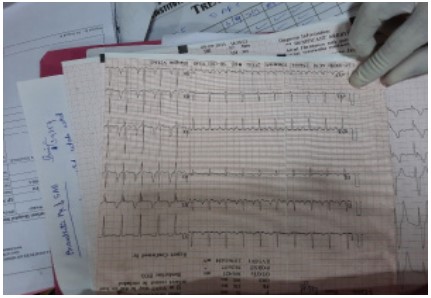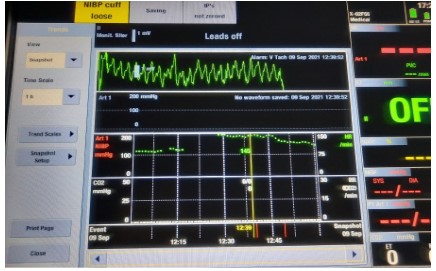Clinical & Medical Surgery
Open Access
Volume 3
Madhuri S Kurdi*; Shrinidhi Sunilkumar; Athira Nair; Amritha Baiju
*Corresponding Author: Madhuri S Kurdi
Department of Anaesthesia, KIMS Hubli, India.
Email: drmadhuri_kurdi@yahoo.com
Article Info
Received: Feb 14, 2023
Accepted: Mar 15, 2023
Published: Mar 23, 2023
Archived: www.jclinmedsurgery.com
Copyright: © Kurdi MS (2023).
Citation: Kurdi MS, Sunilkumar S, Nair A, Baiju A. Erroneous Laboratory Reports - Leading to Catastrophic Patient Outcome. J Clin Med Surgery. 2023; 3(1): 1083.
Introduction
In recent years, increased timely and accurate laboratory test results are being produced and this has led to the clinical laboratory being recognized as the “nerve centre of the diagnostic process” [1]. Laboratory test results play a pivotal role in the diagnosis and management of a patient. Approximately 60–70% of medical decisions related to diagnosis and treatment depend on them [2]. Although, the absolute percentage of errors could appear very low compared to billions of laboratory results, this could become relevant when considered in relation to patient outcome. Quality failures in laboratory medicine have a potential to jeopardise patient safety [3]. Literature shows that errors can occur at any step of the perioperative process, in the pre-analytical, analytical and post-analytical phases and the complex process that finally provide laboratory information is not error-free [4]. Safety to the patient is when there is no accidental or unnecessary harm by the adverse events occurring in any healthcare setting and it directly affects the quality of care [5]. Routine preoperative investigations play an important role in determining the fitness for anesthesia and surgery and they should be advised consistent with the clinical evaluation after considering the presence of medical conditions, current medications, the proposed operative procedure, and the potential for blood loss [6]. This case report demonstrates how an error in laboratory investigation c led to a near miss. Minor errors may have disastrous consequences in highly technical and complicated systems.
Case report
A 46-year-old female, with a height and weight of 158 cm and 53 kg respectively, was scheduled for a diagnostic cystoscopy with bilateral DJ stenting. The patient was a case of obstructive nephropathy due to carcinoma cervix stage III B with moderate anaemia and HIV positive status on anti-retro viral therapy for the past 7 years. Her family history, obstetric history, and social history were unremarkable. On hospital admission, her vital signs included: blood pressure (BP): 110/70 mmHg, peripheral oxygen saturation (Spo2) on room air: 99%, pulse rate (PR): 110 /min. She was conscious, oriented to time, place and person, had moderate pallor and bilateral pitting oedema in the lower limbs. The patient’s vital signs on arrival in the operation room included a BP of 124/72 mmHg and PR of 120 beats per min. Respiratory and cardiovascular examination were unremarkable. Her laboratory investigations revealed: Hemoglobin-8.6 g/dl, blood urea level -55 mg/dl, serum creatinine -4.6 mg/dl, serum potassium -4.1 mmol/L. 2-D Echocardiography (ECHO) was normal. The Electrocardiogram (ECG) displayed sinus tachycardia (110-120 beats per minute at normal intervals) (Figure 1).
With the patient in the sitting position, spinal anaesthesia was administered using a 25-gauge Quincke-type needle with 12.5 mg of bupivacaine heavy at the L3-L4 interspace. The patient was placed in the supine position for 10 minutes, after which the BP lowered to 110/60 mmHg. Shortly after, premature ventricular contractions appeared in the ECG followed by ventricular tachycardia, and the patient’s PR increased to 140 beats per minute and the blood pressure to 90/60 mmHg (Figure 2). The maximal level of the sensory block to cold temperature was T8. The surgical procedure was abandoned. Thereafter, two pints of normal saline were rushed, intravenous amiodarone 300 mg and preservative free lignocaine (LOXcard) 3cc were administered. The PR settled with sine wave pattern on ECG (Figure 3), after which the patient was transferred to the cardiac intensive care unit. Laboratory tests were repeated. Troponin I was negative and 2D echo report showed an ejection fraction of 50%, mild hypokinesia of mid and apical anterior wall, grade II mitral regurgitation, mild tricuspid regurgitation, PASP -45 mmHg and mild pulmonary arterial hypertension.
The repeat serum potassium level was 8.3 mmol/l and creatinine level was 9.7 mg/dl. Hyperkalemia correction and dialysis were done after consulting the cardiologist and nephrologist and the patient stabilised.
Discussion
An act of commission or omission that could have harmed the patient but did not do so as a result of chance, prevention, or mitigation’’ is called a Near-miss. If it is not detected and reduced, it is likely to re-occur and it eventually can result in adverse events [7,8]. Laboratory errors in estimating potassium was the reason behind the Near-miss in our patient. The preoperative potassium level was normal; hence the case was given and the patient landed in a catastrophe. Nevertheless, timely diagnosis and quick clinical decisions saved the patient. There is a requirement for vigilance among laboratory personnel regarding prompt reporting of possible failures. A systematic approach seeking identification of weakness in the total testing process followed by correction in policies and procedures is required [4]. Hence, it is important for all laboratories to identify failures, classify it by cause (i.e., pre-analytical, analytical, post-analytical) followed by grading the seriousness of quality failure. Monitoring and reporting systems play a crucial role in improving patient safety [9,10]. Nonetheless, improvement in perioperative healthcare delivery involves identification of lacunae in the perioperative care system and adopting modern strategies to reduce the same [11]. Our case is an apt example of a lapse in perioperative care which led to a patient-safety related adverse event and gives a strong message regarding the need to improve the quality of perioperative laboratory investigation services.
References
- Chappy S. Perioperative patient safety: a multisite qualitative analysis. AORN journal. 2006; 83: 871-897.
- Aita A, Sciacovelli L, Plebani M. Laboratory-related errors: you cannot manage what you don’t measure. You manage what you know and measure. Diagnosis. 2017; 4: 193-195.
- Astion ML, Shojania KG, Hamill TR, Kim S, Ng VL. Classifying laboratory incident reports to identify problems that jeopardize patient safety. American Journal of Clinical Pathology. 2003; 120: 18-26.
- Kumar A, Srivastava U. Role of routine laboratory investigations in preoperative evaluation. J Anaesthesiol Clin Pharmacol. 2011; 27: 174-179.
- Agarwal R. Measurement of errors in clinical laboratories. Indian Journal of Clinical Biochemistry. 2013; 28: 227-234.
- Kumar A, Srivastava U. Role of routine laboratory investigations in preoperative evaluation. Journal of Anaesthesiology Clinical Pharmacology. 2011; 27: 174-179.
- Leape LL, Brennan TA, Laird N, Lawthers AG, Localio AR, et al. The nature of adverse events in hospitalized patients. Results of the Harvard Medical Practice Study II. N Engl J Med. 1991; 324: 377-384.
- Witte DL, VanNess SA, Angstadt DS, Pennell BJ. Errors, mistakes, blunders, outliers, or unacceptable results: how many?. Clinical Chemistry. 1997; 43: 1352-1356.
- Schiff GD, Aggarwal HC, Kumar S, McNutt RA. Prescribing potassium despite hyperkalemia: medication errors uncovered by linking laboratory and pharmacy information systems. Am J Med. 2000; 109: 494-497.
- Kalra J. Medical errors: impact on clinical laboratories and other critical areas. Clin Biochem. 2004; 37: 1052-1062.
- Bajwa SJS, Mehdiratta L. Adopting newer strategies of perioperative quality improvement: The bandwagon moves on. Indian J Anaesth. 2021; 65: 639-643.


